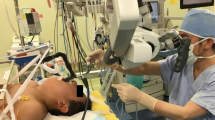Abstract
Recurrent neck lesions associated with third or fourth branchial arch fistula are much less common than those of second arch and usually present with acute suppurative thyroiditis or neck abscess. Our aim is to describe clinical features, management and treatment outcomes of 64 cases of congenital pyriform sinus fistula (PSF). Medical record of these 64 patients (33 males, 31 females) treated at the First Affiliated Hospital of Zhengzhou University from 2011 to 2014 were reviewed. The patients comprised 33 males and 31 females, and their ages ranged from 18 months to 47 years (median 10 years, mean 12.7 years). Neck abscess and recurrent infection was the mode of presentation in 37 cases (57.8 %), 4 patients (6.3 %) presented with acute suppurative thyroiditis, neck mass was the mode of presentation in 17 cases (26.6 %), 2 patients (3.1 %) presented with neck mass with respiratory distress, and cutaneous discharging fistula was the mode of presentation in 1 cases (1.6 %). The remaining 3 patients (4.7 %) presented with cutaneous discharging fistula with neck infection. Investigations performed include barium swallow, CT scan, and ultrasound which were useful in delineating PSF tract preoperatively. Barium swallow was taken as the gold standard for diagnosis. Our patients were treated by fistulectomy with hemithyroidectomy, fistulectomy, fistulectomy with endoscopic electric cauterization, endoscopic electric cauterization or endoscopic coblation cauterization, respectively. Histopathologic examination of the surgical specimens revealed that they were lined with ciliated epithelium, stratified cuboid epithelium with chronic inflammatory cell infiltration and fibrosis. Voice hoarseness occurred after operation in seven patients, but disappeared 1 week later. PSF recurred in 6 patients, 4 of them were cured by a successful re-excision. One patient was cured by successful endoscopic electric cauterization. The other 1 has remained asymptomatic for 5 months. In our series, mean follow-up period was 13.3 months and median follow-up period was 12.5 months (range 2–40 months). Presence of congenital PSF should be suspected when intra-thyroidal abscess formation occurs as the gland is resistant to infection. Strong clinical suspicion, barium swallow study, CT scan and ultrasound are the key to diagnosis. Both fistulectomy with hemithyroidectomy and endoscopic treatment have comparable success rate. Endoscopic coblation cauterization may prove a useful and equally effective method of treatment for PSF in future.





Similar content being viewed by others
References
Mukerji SS, Parmar H, Ibrahim M, Bradford C (2007) An unusual cause of recurrent pediatric neck abscess: pyriform sinus fistula. Clin Imaging 31(5):349–351
Madana J, Yolmo D, Gopalakrishnan S, Saxena SK (2010) Complete congenital third branchial fistula with left-sided, recurrent, suppurative thyroiditis. J Laryngol Otol 124(9):1025–1029
Liberman M, Kay S, Emil S et al (2002) Ten years of experience with third and fourth branchial remnants. J Pediatr Surg 37(5):685–690
Cespedes C, Duran P, Uribe C et al (2013) Thyroid abscess. A case series and literature review. Endocrinol Nutr 60(4):190–196
Madana J, Yolmo D, Saxena SK, Gopalakrishnan S (2010) Thyroid abscess with branchial anomaly. Int J Pediatr Otorhinolaryngol Extra 5(4):170–173
Madana J, Yolmo D, Kalaiarasi R et al (2011) Recurrent neck infection with branchial arch fistula in children. Int J Pediatr Otorhinolaryngol 75(9):1181–1185
Nicoucar K, Giger R, Pope HG Jr et al (2009) Management of congenital fourth branchial arch anomalies: a review and analysis of published cases. J Pediatr Surg 44(7):1432–1439
Author information
Authors and Affiliations
Corresponding author
Rights and permissions
About this article
Cite this article
Zhang, P., Tian, X. Recurrent neck lesions secondary to pyriform sinus fistula. Eur Arch Otorhinolaryngol 273, 735–739 (2016). https://doi.org/10.1007/s00405-015-3572-2
Received:
Accepted:
Published:
Issue Date:
DOI: https://doi.org/10.1007/s00405-015-3572-2




